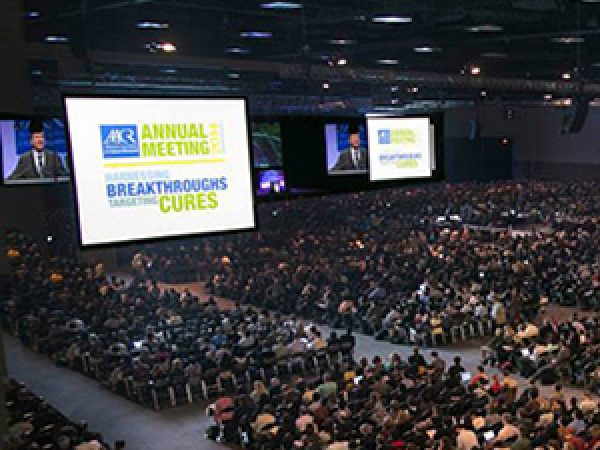Upcoming AACR Meeting Focuses on Recent Advances in Pancreatic Cancer Research
Pancreatic cancer is projected to become the second leading cause of cancer mortality in the United States by 2030. The prognosis for this disease remains grim: The overall five-year survival rate is lower than 10 percent, and this rate drops to less than 3 percent if the disease is identified after the cancer has metastasized, a stage at which more than half of pancreatic cancers are diagnosed.
“Late detection is a hallmark of pancreatic cancer,” began Dafna Bar-Sagi, PhD, a Fellow of the AACR Academy. Bar-Sagi is one of the cochairs of the upcoming American Association for Cancer Research conference, Pancreatic Cancer: Advances in Science and Clinical Care, to be held in Boston September 6-9, and Vice Dean for Science at NYU Langone Health.
A major reason for this phenomenon is lack of specific symptoms that are associated with the disease, Bar-Sagi noted. “Because of the location of the pancreas in the body, it’s extremely difficult to image with the kind of clarity we need in order to identify early or premalignant lesions,” she added. “Further, there are no reliable biomarkers for early detection of pancreatic cancer and therefore most patients present with advanced disease.”
To combat this bleak prognosis, the pancreatic cancer research community has grown tremendously in recent years, said Bar-Sagi. “The access to advanced technologies and new clinical approaches has accelerated the pace of discoveries and prompted the need to bring the community together frequently in order to capitalize on this progress,” she said. Responding to the growth of this key field, this AACR conference is transitioning from a biennial series to a yearly conference, with the 2019 program representing the first of the annual series.
Bar-Sagi went on to describe some of the topics that will be covered during the meeting.
Modulating the immunosuppressive tumor microenvironment
The pancreatic cancer microenvironment is often highly immunosuppressive, rendering the disease less responsive to treatment, notably to immunotherapy. As a result, modulation of the tumor microenvironment (TME) could be an effective strategy to counteract the inherent nonimmunogenecity of these tumors, Bar-Sagi explained.
“Several strategies to modulate the TME in pancreatic cancer are under study, including the development of therapeutic vaccines, which target antigens that are presented specifically on the tumor cells,” Bar-Sagi said. “Another approach is to target a specific subpopulation of immunosuppressive cells.”
She, however, likened the process of targeting players in the TME to playing a game of Whac-A-Mole: once one particular immunosuppressive cell population is targeted, another may emerge and continue to effectively suppress the immune response. “Finding one critical immune-cell population is likely not even tenable – we’ll need to target multiple cell populations at once in order to eliminate this armory of immune suppression,” she said.
Modulation of the TME will be discussed in a plenary session at the upcoming meeting.
Targeting oncogenic RAS signaling
The RAS gene family, which encode key proteins involved in cell proliferation and cell death, are known oncogenic drivers of approximately a third of human cancers. It is estimated that roughly 95 percent of pancreatic cancers have mutations in the KRAS gene. Mutations in KRAS can result in the production of a constitutively active form of the protein, fueling uncontrolled cellular growth that can lead to cancer.
While early results from clinical trials evaluating the KRAS inhibitor AMG 510 show promise in patients with non-small cell lung cancer and colorectal cancer, this drug is not likely to be beneficial for many patients with pancreatic cancer. “This drug specifically targets KRAS with the G12C mutation, which is uncommon in pancreatic cancer, so only a small minority of patients will qualify for this targeting approach,” Bar-Sagi said.
In terms of targeting KRAS or its effectors in pancreatic cancer, Bar-Sagi believes that the sole inhibition of this oncogenic network is only part of the solution for disease control. “Inhibiting RAS signaling might help to halt the disease for a time, but this approach is unlikely to result in a cure,” she said. “These cancer cells have a phenomenal biological plasticity which is likely to enable them to adapt to the loss RAS signaling by engaging compensatory mechanisms. Identifying the drivers of this plasticity will be key for the development of effective targeting strategies.”
A plenary session at the conference, chaired by Bar-Sagi, will focus on RAS and oncogene signaling.
Early detection: a holy grail in pancreatic cancer
Prevention and early detection, which will be highlighted in a plenary session at the meeting, represent major challenges in the field of pancreatic cancer.
“Only a small number of pancreatic cancer patients succumb to this disease because of genetic susceptibility,” Bar-Sagi mentioned. “As such, we don’t have a good understanding of risk factors, or which individuals should undergo screening for pancreatic cancer.”
Bar-Sagi spoke of the emergence of computational research strategies to help identify patients who are at elevated risk for developing pancreatic cancer. “Using AI [artificial intelligence] and machine learning approaches to analyze large sets of clinical records and images, it might be possible to develop predictive models for high-risk patients,” she noted. “If successful, such models could dramatically change the landscape of the disease for patients and their families, not only in terms of early detection, but perhaps also in terms of understanding how pancreatic cancer can be prevented.”
Other efforts in the area of early detection include the development of non-invasive molecular imaging modalities and liquid biopsy techniques.
“Pancreatic cancer claims roughly 50,000 people per year in the United States,” noted Bar-Sagi. “Advances in early detection will improve patient outcomes and increase survival rates,” she concluded.
Interested in learning more about the meeting? Watch this interview with conference cochair Ben Stanger, MD, PhD, about what to expect in Boston later this week:





